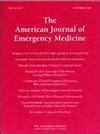Comparative analysis of APUA, APUA-RO₂, and CURB-65 scores for mortality risk in hospitalized pneumonia patients
IF 2.2
3区 医学
Q1 EMERGENCY MEDICINE
引用次数: 0
Abstract
Background
Early identification of patients at high risk of mortality in community-acquired pneumonia (CAP) is critical for clinical decision-making. While the CURB-65 score is widely used, simplified tools such as APUA and APUA-RO₂ have been proposed to improve risk stratification by incorporating fewer and more accessible parameters.
Methods
This retrospective single-center study included adult patients (≥18 years) hospitalized with CAP between January 2023 and December 2024. The APUA, APUA-RO₂, and CURB-65 scores were calculated based on admission data. The primary outcome was 30-day in-hospital mortality. The predictive performances of the scores were compared using receiver operating characteristic (ROC) curve analysis, and AUCs were statistically compared using the DeLong test.
Results
A total of 348 patients were included; the in-hospital mortality rate was 32.5 %. The area under the curve (AUC) for APUA-RO₂ was 0.716 (95 % CI, 0.657–0.774), for CURB-65 was 0.716 (95 % CI, 0.662–0.770), and for APUA was 0.658 (95 % CI, 0.596–0.719). APUA-RO₂ showed significantly better discriminatory ability than APUA (P < .001). No significant difference was observed between APUA-RO₂ and CURB-65 (P = .976).
Conclusion
Both APUA-RO₂ and CURB-65 demonstrated moderate and comparable accuracy in predicting 30-day mortality in hospitalized CAP patients. The APUA-RO₂ score may be a practical alternative to existing tools, offering a balance between simplicity and prognostic utility.
APUA、APUA- ro₂、CURB-65评分对住院肺炎患者死亡风险的比较分析
背景:准确识别社区获得性肺炎(CAP)死亡率高的患者对临床决策至关重要。虽然CURB-65评分被广泛使用,但已经提出了简化的工具,如APUA和APUA- ro₂,通过纳入更少和更容易获得的参数来改善风险分层。方法本回顾性单中心研究纳入2023年1月至2024年12月住院的成年CAP患者(≥18岁)。根据入院数据计算APUA、APUA- ro₂和CURB-65评分。主要终点是30天住院死亡率。采用受试者工作特征(ROC)曲线分析比较评分的预测性能,采用DeLong检验比较auc。结果共纳入348例患者;住院死亡率为32.5%。APUA- ro 2的曲线下面积(AUC)为0.716 (95% CI, 0.657 ~ 0.774), CURB-65的曲线下面积为0.716 (95% CI, 0.662 ~ 0.770), APUA的曲线下面积为0.658 (95% CI, 0.596 ~ 0.719)。APUA- ro₂的区分能力明显优于APUA (P <;措施)。APUA-RO 2与CURB-65无显著差异(P = .976)。结论APUA-RO₂和CURB-65在预测CAP住院患者30天死亡率方面均具有中等和相当的准确性。APUA-RO₂评分可能是现有工具的实用替代方案,在简单性和预后实用性之间提供了平衡。
本文章由计算机程序翻译,如有差异,请以英文原文为准。
求助全文
约1分钟内获得全文
求助全文
来源期刊
CiteScore
6.00
自引率
5.60%
发文量
730
审稿时长
42 days
期刊介绍:
A distinctive blend of practicality and scholarliness makes the American Journal of Emergency Medicine a key source for information on emergency medical care. Covering all activities concerned with emergency medicine, it is the journal to turn to for information to help increase the ability to understand, recognize and treat emergency conditions. Issues contain clinical articles, case reports, review articles, editorials, international notes, book reviews and more.

 求助内容:
求助内容: 应助结果提醒方式:
应助结果提醒方式:


